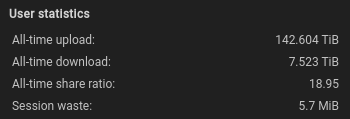- 0 Posts
- 29 Comments

 11·1 month ago
11·1 month agoYou’re not wrong, but it bugs me when my ratio drops, so I always seed everything I download. I have a pretty good internet service though.
My stats:

Linux uses 8 spaces. Excerpt from the official style guide:
Tabs are 8 characters, and thus indentations are also 8 characters. There are heretic movements that try to make indentations 4 (or even 2!) characters deep, and that is akin to trying to define the value of PI to be 3.
Rationale: The whole idea behind indentation is to clearly define where a block of control starts and ends. Especially when you’ve been looking at your screen for 20 straight hours, you’ll find it a lot easier to see how the indentation works if you have large indentations.
Now, some people will claim that having 8-character indentations makes the code move too far to the right, and makes it hard to read on a 80-character terminal screen. The answer to that is that if you need more than 3 levels of indentation, you’re screwed anyway, and should fix your program.
In short, 8-char indents make things easier to read, and have the added benefit of warning you when you’re nesting your functions too deep. Heed that warning.
The reasoning seems sound, but I still prefer 4 personally.

 1·3 months ago
1·3 months agogdu is another alternative. It is sometimes faster than ncdu for me.

 1·6 months ago
1·6 months ago(Preface: i dont know much about this)
mkdev.h is not available in arch either. I even tried searching the repos with
pacman -F mkdev.h.Looking up makedev (which I’m assuming is the lib that cpio uses from it) it seems that it is available in sysmacros.h for linux and mkdev.h for solaris, see for example: https://patchwork.kernel.org/project/dri-devel/patch/1436377303-28355-1-git-send-email-alan.coopersmith@oracle.com/
So I tried just commenting that include out but got a bunch of other errors about multiple definitions of some enums (defined in cpio.h), and so I gave up.
I don’t like GNU either but I went the more free route of BSD instead.

 12·8 months ago
12·8 months agoIt’s when you open a publicly facing port and map (forward) it to a local port your machine. In this case, it’s opened at the vpn provider’s public gateway. Otherwise, it would typically be opened in your router instead.
You can then configure your torrent client to listen on that local port that the public port is forwarded to. I think generally the public and the local port are the same number when using VPN.
If you do that, then others have the ability to initiate a connection to you instead of only you being able to initiate the connection to somebody else.
When seeding/leeching to/from someone else, at least one of you needs a port open. So, if you always have one open, you allow yourself to connect to anyone on the network regardless if they have one open or not.
Sorry if I confused you more, I’m not that great at explaining.

 9·8 months ago
9·8 months agoI seed without cap, don’t really need my upload for anything else. (500 Mbps)
What’s the distro? I can help seed it indefinitely with open ports.

 11·9 months ago
11·9 months agoHuh? Yes it does. Unless you mean it’s not cracked yet.

 2·10 months ago
2·10 months agodeleted by creator

 5·10 months ago
5·10 months agoDid you have to enable non-free for that? Or, I guess, nowadays it would probably be in non-free-firmware.

 4·1 year ago
4·1 year agoPF works with proton, I use it. But you have to continuously call it to stay open. (On linux)

 6·1 year ago
6·1 year agoWhat i found to work the best is to generate and download a config file, then import it into NetworkManager. There’s a plugin for wireguard here: https://github.com/max-moser/network-manager-wireguard
This way, it’s easy to add routes, autostart, etc. But I don’t think a safe killswitch is possible.
Edit: But since this is a piracy community, i should mention that qbittorrent has a setting for specifying the network interface, so it’s easy to force it to use the vpn connection only, in place of a killswitch.

 218·1 year ago
218·1 year agoIt seems to me that you misunderstand what artificial intelligence means. AI doesn’t necessitate thought or sentience. If a computer can perform a complex task that is indistinguishable from the work of a human, it will be considered intelligent.
You may consider the classic turing test, which doesn’t question why a computer program answers the way it does, only that it is indiscernable from a human response.
You may also consider this quote from John McCarthy on the topic:
Q. What is artificial intelligence?
A. It is the science and engineering of making intelligent machines, especially intelligent computer programs. It is related to the similar task of using computers to understand human intelligence, but AI does not have to confine itself to methods that are biologically observable.
There’s more on this topic by IBM here.
You may also consider a few extra definitions:
Artificial Intelligence (AI), a term coined by emeritus Stanford Professor John McCarthy in 1955, was defined by him as “the science and engineering of making intelligent machines”. Much research has humans program machines to behave in a clever way, like playing chess, but, today, we emphasize machines that can learn, at least somewhat like human beings do.
Artificial intelligence (AI) is the field devoted to building artificial animals (or at least artificial creatures that – in suitable contexts – appear to be animals) and, for many, artificial persons (or at least artificial creatures that – in suitable contexts – appear to be persons).
artificial intelligence (AI), the ability of a digital computer or computer-controlled robot to perform tasks commonly associated with intelligent beings
That would be similar to saying you are assuming the user has opened the gui application, not just randomly clicking the desktop.
Of course I’m assuming they already know what application they want to use before exploring its capabilities.
$ command -h $ command --help $ man commandI have a lot of tab completions installed, too, so i can also just hit tab to get a list of all possible options, etc.

 9·1 year ago
9·1 year agoThere’s definitively more to a distro than the shell prompt and wallpaper.
Besides the obvious package repos and how well package interoperability is maintained, there’s also differences for default configuration. OpenSUSE offers sane options for security OOtB, IMO.
Then there’s also linux itself. Some distros build the default kernel package with a set of patches to improve typical usability, while others just ship an untouched upstream version. Some offer alternatives while others don’t.

 3·1 year ago
3·1 year agoMore bloat from flatpak overhead :^)

 17·1 year ago
17·1 year agoI’m a simple man, I just search directly in qbittorrent.


Codeberg looks pretty good at a quick glance.